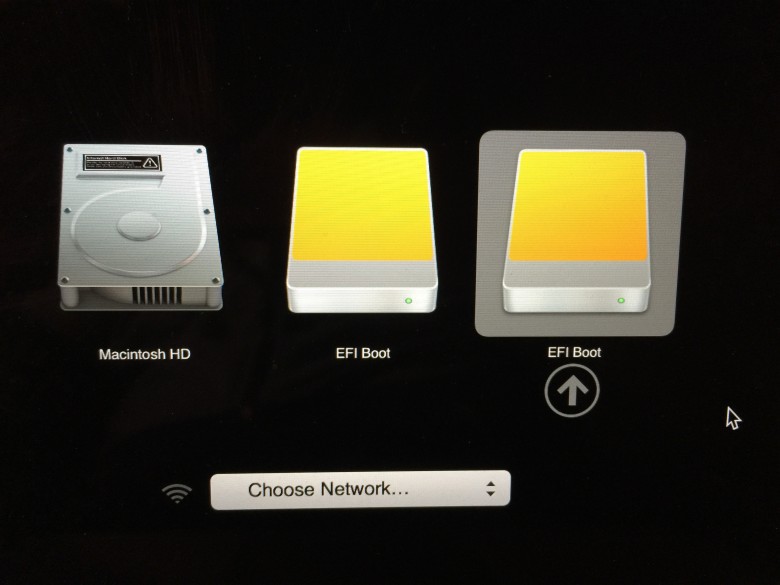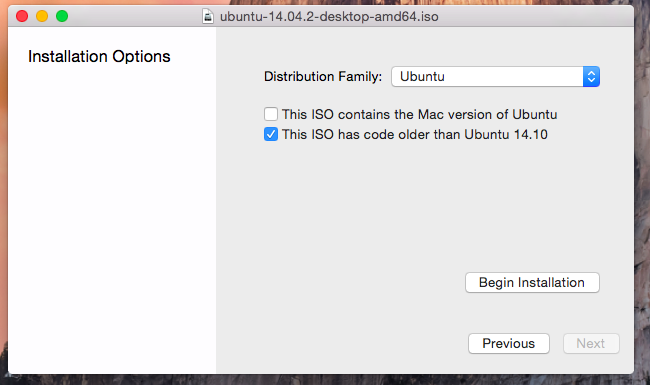- This will give you a chance to test your Mac's hardware compatibility with Ubuntu. – David Anderson Jan 25 '18 at 12:45 So, after finishing all steps up until 'Replace Ubuntu Server with Ubuntu Desktop' I reboot, but instead of the GRUB boot screen I get stuck with 'No bootable device.
- Instant Ubuntu VMs. On-demand VMs for cloud devs on Windows, Mac and Linux desktops with Multipass.
- Ubuntu 16.04.4 -(Mac) -(Live USB with persistence) -(Created with UNETBootin) First boot, the home screen shows up and i see the cursor at the center of the screen but nothing works (neither mouse or keyboard). I read online that they forgot to install the package during the update or something like this, but I don’t really know how to fix it!
Bootable USB flash drives has become popular, given that it is easy to create, it comes in handy, accessible, and very convenient. You might have a damaged installation on your operating system. Or you might need an upgrade to the newest version available. Your new computer or laptop did not have an operating system with it. Whatever the reason may be, bootable USB flash drives makes it easier for everyone to re-install or install an operating system to your laptops and computers. Here is a list of benefits of having a bootable USB flash drive:
- USB flash drives are compatible to all laptops and computers. You might have noticed that laptops and computers have USB ports but not all laptops and computers have a CD drive or DVD drive.
- Faster transfer speed. USB flash drives pretty much transfers data faster than SD cards.
- You can bring the USB flash drive with you anywhere without a hassle. You can just put in your pocket, or in your bag without an added weight since it is very light.
How to get Ubuntu 18.04 (Linux) on a Mac running macOS or Mac OS X. This process is called a dual boot. Links: My website to get the bootable drive maker: ht. Get the ISO-2-USB EFI-Booter for Mac 0.01 beta and a recent version of Ubuntu Desktop Edition 64bit. Format a USB drive to provide a single FAT32 partition featuring MBR. Create the following directories on your USB drive: /efi and /efi/boot. Copy the bootX64.efi from “ISO-2-USB EFI-Booter for Mac 0.01 beta” into /efi/boot on your USB Drive.
Basically, you only need three things to make a Ubuntu bootable USB flash drive:
- Etcher – the software that we are going to use to create a bootable USB flash drive
- Ubuntu – an operating system that we are going to write on your USB flash drive
- USB flash drive – well, I am just stating the obvious
Etcher, or balenaEtcher, is a free program and an open source utility. Etcher is primarily used to write image files like .img and .iso files to create a bootable USB flash drive. Here is a list of the things that you would love about Etcher (balenaEtcher):
- GUI (Graphical User Interface) looks great.
- It works fast.
- Free to use! Who would not love anything that is free?
- Easy to use. It is very user-friendly.
Ubuntu, is an open source operating system. It is under the Linux distribution based on Debian. And here is a list of the things that you would love about Ubuntu:
- You do not have to pay anything because Ubuntu is totally free! Other operating systems would cost you money so why not go with Ubuntu, right?
- It has better security compared to other operating systems.
- It is resource-friendly. Meaning to say that it can still run on older hardware. So, that means you can still use your older laptops and computers with this operating system.
- It is customizable. Which means that you can personalize the user interface however you want it!
- Ubuntu is an open source program. This means that you can go through the source code and contribute to innovate and improve the operating system.
- It saves your time. Ubuntu can actually install the updates in the background so you won’t have to restart your laptops or computers.
- It is suited for development. It is helpful for programmers with all the aid to make things a whole lot easier and convenient.
Here is how to make a Ubuntu Bootable USB flash drive with Etcher (balenaEtcher)
Step 1: Download the latest Ubuntu ISO file
- To download the Ubuntu ISO file, you can get it here: https://www.ubuntu.com/download/desktop
- Go ahead and copy and paste the link above to a browser
- Look for the latest version of Ubuntu and go ahead and click Download.
As per Ubuntu’s website, please take note of the recommended system requirements:
- 2GHz dual core processor or higher
- 4GB system memory
- 25 GB of free hard drive space
- USB port for the installer media
- Preferably with internet access
P.S.
It is always better to download the latest version of this operating system.
Step 2: Download the latest Etcher
- If you do not have the Etcher yet, you can get it here: https://www.balena.io/etcher/
- Click Download
- Once the download has finished, double click on the file
- The Installation Wizard will be launched, just follow the steps accordingly.
Step 4: Plug in your USB flash drive to your laptop or computer’s USB port
- Go ahead and plug the USB flash drive to your laptop and computer’s USB port
- Make sure that the USB flash drive has 2GB of storage or larger
P.S.
To avoid confusion, make sure to only plug in the USB flash drive that you are going to use to create a bootable USB flash drive. And since we are going to write on your USB flash drive, do not forget to back it up otherwise the content will be deleted.
Step 5: Select the Ubuntu ISO file
- Once you have launched Etcher, click on “Select image”
- Go ahead and locate the Ubuntu ISO file that you have downloaded earlier (usually this is saved on your Downloads folder not unless you have saved the file on a different location)
Step 6: Select the Drive
- Go ahead and click “Select Drive”
- Choose the USB flash drive that you are going to use to create a bootable USB

P.S.
If you have multiple USB flash drives plugged into your laptop or computer, make sure that you have checked the name of the drive where the USB flash drive is plugged into. You do not want to choose the incorrect one. Remember, all files will be deleted.
If you only have one USB flash drive plugged into your laptop or computer, Etcher will automatically detect and have the device pre-selected.
Important note for Microsoft 365 subscriptions: After September 22, 2016, Office 2011 for Mac is no longer available for installation with a Microsoft 365 subscription.This doesn't affect one-time purchases of Office for Mac 2011 such as, Office Home and Student, Office Home and Business,. Microsoft office 2011 professional edition mac.
Step 7: Double check your selection
- Before we proceed with the flashing process, go ahead and double check first that you have selected the correct Ubuntu ISO file
- And then also double check that you have selected the correct device
Step 8: The Flashing Process
- Once you are sure that you have all the correct selection, go ahead and click the flash image
- The flashing process will now then start and a progress bar will be shown directly below the flash image
- Once the flashing process is completed, it will let you know that the flash is complete
So, there you have it. You have successfully made a Ubuntu bootable USB with Etcher!
Last Updated on April 10, 2020 by Etcher
With Ubuntu 16.04 LTS inching ever closer to release, now feels like a good time to recap how easy it is to make an bootable Ubuntu USB drive.
Just like the live CD, a live Linux USB allows you to boot Ubuntu on your machine without needing to install it on your hard-drive. Live images are a useful way to test hardware compatibility (things like Wi-Fi drivers, touch-screens, etc) before committing to a full install.
In this article we show you 3 ways of making a bootable thumb drive on the 3 major desktop operating systems: Windows, OS X and Ubuntu.
How to Create a Bootable Linux USB Drive on Windows
Our preferred tool for creating bootable Ubuntu sticks in Windows is ‘Linux Live USB Creator’ – often called ‘Lili’ for short.
The free and open-source app is incredibly straightforward to use. Just follow each step in turn. It’ll even download the .iso file for you if you don’t have one to hand.
Burn Ubuntu Image To Usb
If you don’t like this app (or can’t get it run) there are alternatives, including Rufus (Github link)
Kartina.TV reserves the right to remove or addindividual channels at its own discretion. We are constantly working onimproving and updating the service to guarantee the best quality for our customers. Kartina for mac. The number of channels stated on the website is non-binding and may vary depending on thecountry where the service is provided.

How to Create a Bootable Linux USB Drive on Mac OS X
For an OS that’s prized for its simplicity it’s strange that creating a bootable USB on a Mac is not easy.
But it’s not impossible, either.
Canonical recommend a command-line method to create a bootable USB with Ubuntu on Mac O SX. The instructions are concise though the process is involved.
For something less longwinded you could give the open-source, cross-platform UNetBootin app a go.
It has to be said that while the success rate of images created using this app is poor (you can’t use the USB’s it creates to boot a Mac, for instance) it is the ‘easiest’ way to create a bootable Ubuntu USB on Mac OS X.

Like LiLi above, Unetbootin can even automatically download a Linux distro .iso file, which is handy if you feel the itch to distro hop but don’t know exactly which flavor to try.
Remember that to boot from a USB on a Mac you will need to hold down the Alt/Option’ key during boot.

Other GUI alternatives include
How to Make a Bootable Linux USB Drive on Ubuntu
Ubuntu comes with an app to create live USB drives already installed.
Open the Dash and search for ‘USB Startup’.
Launch the app, locate your .iso file, choose your USB drive (double check it’s the correct one!) and then hit ‘install’.
Ubuntu Live Usb Download
You can also configure persistence though I’ve never had a USB boot when I’ve enabled this feature.
Ubuntu Usb Mac Terminal
What’s your preferred method for creating bootable Linux USB drives? Let us know in the comments!
